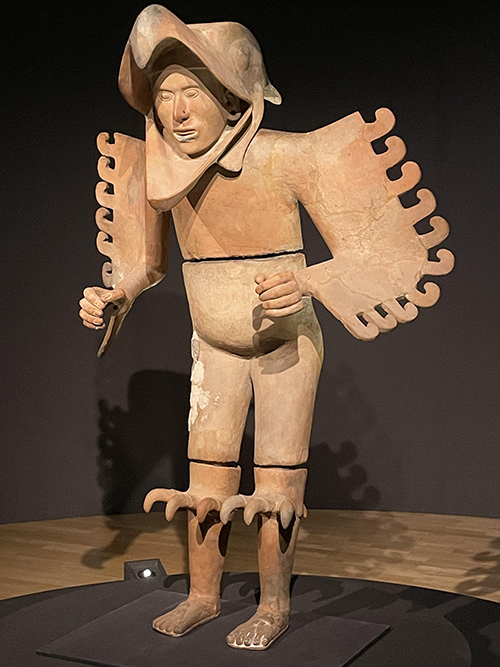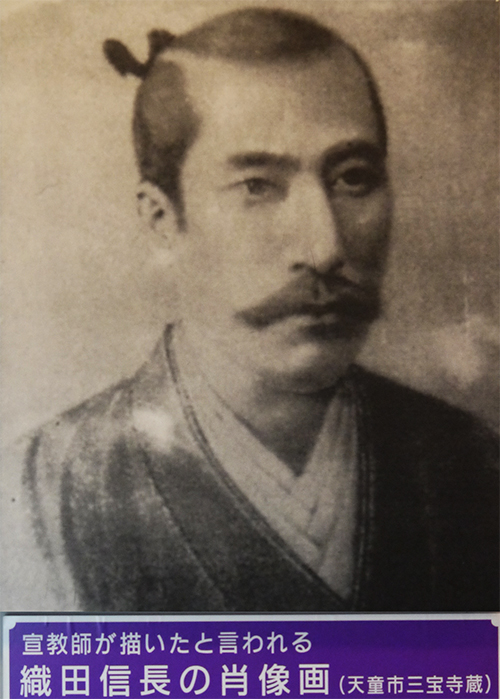

メキシコでアステカが繁栄した時代、活発な国内的内戦状況という似たような状況だった日本では、織田信長からはじまる天下統一の動きが活発化していた。
写真上は、アステカの戦士の勇猛さを表現したとされる「鷲-ワシ-の戦士像」。制作年代は1469-86の期間とされている。一方の織田信長の肖像画は、その伝承を信じれば当時日本に布教のために来日していた西洋の宣教師たちが描いたものという。没年月日が1582年6月21日でその数年前に描かれたものと推測される。たぶん100年前後のズレはあるけれど、メキシコと日本の状況を対比させるには、ひとつの見方のようにも思える。
アステカ戦士像は、戦闘や宗教において重要な役割を担った勇敢な軍人を顕彰した像といえる。鷲の羽毛やかぎ爪の装束を身に付けている。戦闘において勇ましく戦死したことで昇天に際してこのように姿を変えた、天に召されたというように偶像化させたものだろう。太陽神の見える化か。
特別展で実際に参観したときには、その実物大、リアリティともいかにも衝撃的で、いまにも見る者に襲いかかってきそうな鋭い眼光と体勢に身構えさせられた。アステカでは太陽神信仰そのものに関わって戦争行為が行われたような側面を感じる。
一方、戦闘の苛烈さでは決して引けを取らない日本史では、このような戦士の偶像化という文化は起こらなかった。その防備品である鎧兜などの「工芸品化」は進んだけれど、戦争は領土の権益を得るための手段であり、政治闘争が極限化されたものという側面が強い。
アステカは戦争フェッチを偶像化にまで高めているけれど、日本の戦国は最終勝利者・徳川家康という大「政治家」を生み出して終了したというのが日本史の大きな流れ。
日本ではそういうことで武力の神格化みたいなことは生起しなかった。織田信長は自ら神になろうとしたとされている。安土城には自らを神格として祀る神社があったとも言われる。後世になって徳川家康も東照大権現として祀られたけれど、しかし偶像化には進まなかった。せいぜいが建築の荘厳化ということに留まっていた。
信長が自身の肖像画を西洋の宣教師たちが描かせたということに、むしろ大きな意味が感じられる。やはり中国大陸とも、西洋文明とも豊かな「交流」の経験知を積み上げてきた日本史の特性をそこに感じさせられる。相対的価値感を受容する柔軟性だろうか。
一方、やはりメキシコは孤立的な文明圏であって独自の宗教性がすべてにおいて大きく影響を持たざるを得なかったということなのではないか。
English version⬇
[Aztec warrior idols vs. Oda Nobunaga, Ancient Mexico-10
A society that deifies and idolizes the concept of a warrior, and a flexible society that allows the warlord himself to have his portrait painted by pagans. Differences in values across the Pacific Ocean. …
During the period of Aztec prosperity in Mexico, a similar situation of active domestic civil war prevailed in Japan, where a movement to unify the country under the rule of Nobunaga Oda was gaining momentum.
The top photo is the “Eagle Warrior,” which is said to represent the bravery of Aztec warriors. It is believed to have been created during the period 1469-86. The portrait of Nobunaga Oda, on the other hand, was painted by Western missionaries who had come to Japan to proselytize, if tradition is to be believed. The date of his death is June 21, 1582, and it is assumed that it was painted a few years before that date. Although there is probably a discrepancy of around 100 years, it seems to be one way to contrast the situation in Mexico and Japan.
The statues of Aztec warriors can be said to honor brave soldiers who played important roles in battle and religion. They are dressed in eagle feathers and clawed garb. The statues are probably idolized as if they were transformed into this form on their ascension to heaven after having died valiantly in battle. A visualization of the sun god?
When I actually visited the statue at the special exhibition, I was shocked by its real size and reality, and was made to brace myself by its sharp eyes and stance, as if it were about to attack the viewer at any moment. The Aztecs seem to have been involved in warfare as a part of their belief in the sun god itself.
On the other hand, in Japanese history, which is by no means inferior in terms of the intensity of battle, this culture of idolizing warriors did not occur. Although the “crafting” of armor and helmets, which were the armor of the warriors, did advance, war was still a means to gain territorial gains and a political struggle taken to the extreme.
The Aztecs have elevated the war fetish to idolization, but the major trend in Japanese history is that the warring states in Japan ended with the creation of a great “politician” named Tokugawa Ieyasu, the final victor.
In Japan, that kind of deification of military power did not occur. It is said that Oda Nobunaga tried to become a god himself. It is said that there was a shrine in Azuchi Castle that enshrined him as a deity. In later times, Tokugawa Ieyasu was also enshrined as Tosateru Daigongen, but he did not go on to become an idol. At best, it was a solemnization of the architecture.
The fact that Nobunaga had his own portrait painted by Western missionaries is rather significant. This is a characteristic of Japanese history, which has accumulated a wealth of experience and knowledge of exchanges with both mainland China and Western civilization. Perhaps it is the flexibility to accept a relative sense of value.
On the other hand, Mexico was an isolated civilization, and its unique religiosity must have had a significant influence on everything.
Posted on 9月 27th, 2023 by 三木 奎吾
Filed under: 歴史探訪







コメントを投稿
「※誹謗中傷や、悪意のある書き込み、営利目的などのコメントを防ぐために、投稿された全てのコメントは一時的に保留されますのでご了承ください。」
You must be logged in to post a comment.